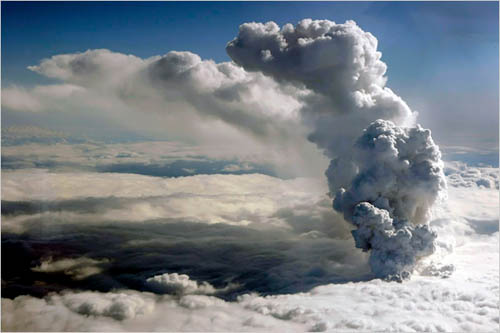 [Image: Photo by Arni Saeberg/Bloomberg].
[Image: Photo by Arni Saeberg/Bloomberg].
One of many things interesting to me about the ongoing volcanic eruption in Iceland is the fact that it has generated a new weather system made of glass: its own “maelstrom of microscopic volcanic glass shards” that liquify and go molten inside passing airplane engines, causing failure.
If you had told me that a new science fiction novel just come out featuring a planet on which vast turbulent structures of glass move through the global atmosphere, posing a dire threat to machinery and drifting across whole continents in a kind of low-intensity storm of aerosolized crystal, I would, naively, never have assumed that such a thing might also be possible here on earth. The speculative climatology of alien worlds.
 [Image: Photo by AP Photo/Brynjar Gaudi].
[Image: Photo by AP Photo/Brynjar Gaudi].
But, perhaps, if airplane engines are built to fly through air—i.e. not through glass, dust, rocks, or geology—today’s airplanes should be temporarily retrofitted with tunneling equipment under each wing, jury-rigged Herrenknecht machines to drill a new infrastructure of hovering tunnels through the glass-thundering skies of northern Europe.
Those eruptions are spectacular and the mention of science fiction is appropriate. Speaking of the atmosphere and sci fi, how come there was no mention here of that immense fireball caused by the meteor streaking over northern Iowa and landing in Wisconsin (I guess this confirms the Midwest is truly flyover territory)? It's rare for such a fireball to be seen over land, most hit over water. The vids and pics are spectacular (http://www.youtube.com/watch?v=TR2uNajroOM).
Also, it looks like the birthplace of the small government movement, Colorado Springs, is set to dispute many of the topics such as spaces and green spaces that Geoff's blog has advocated and discussed. Taxi drivers relieve police at night, volunteers clean parks (for those that don't want to pay for things they never use), and street lights, no longer needed to keep streets safe, are turned off at night (you can rent on for $100 a year though). I picked up this discussion on a Brookings sponsored sub-site here: (http://www.tnr.com/blog/the-avenue/annals-the-fiscal-crisis-colorado-springs). And of course, those volunteers are going to volunteer forever for those that never do, right?
Geoff, it looks like you and those like you in architecture/designscape/planning occupations may be out of business someday in the not-too-distant future if the not-from-my-wallet crowd wins the day. Bah, plans, who needs them?
I wonder if the shards carry any net electrical charge, i.e. an electromagnetic field of some sort may be able to shunt them out of the way? Superconductors or maybe high-tesla permanent magnets? Silica is a semiconductor so the electromagnetic properties of the glass may vary, rendering this idea useless (since a positively charged cone would push away the positively charged shards but yank in the negatively charged ones). The size of the particles also matters, with increasing size you need increasing charge in your field to affect the particles.